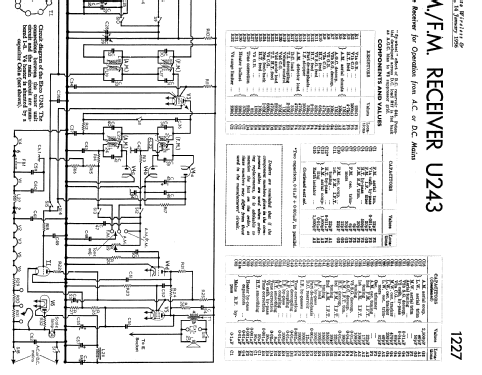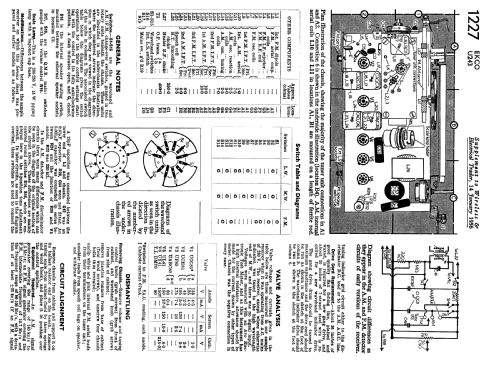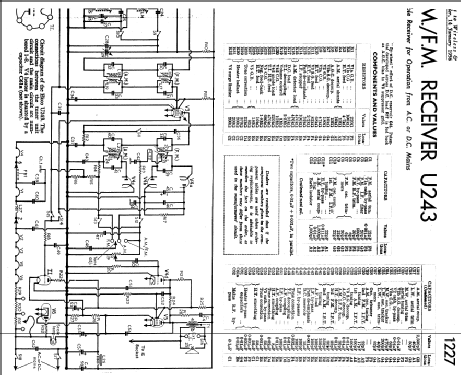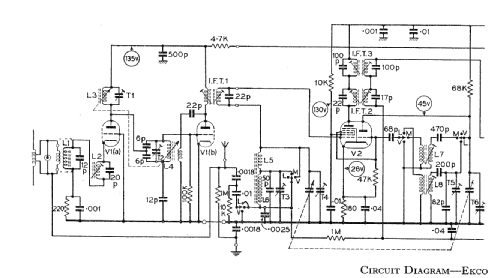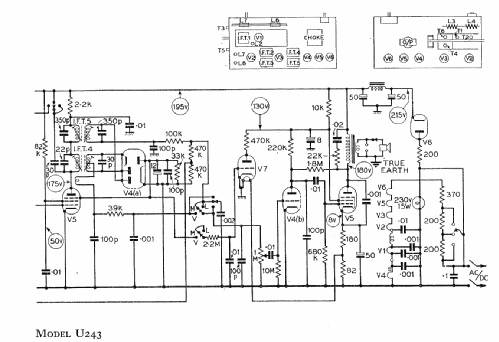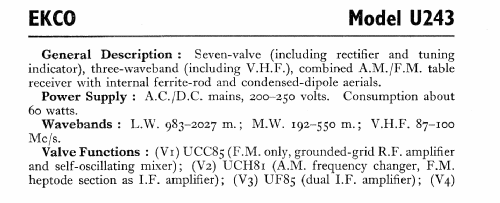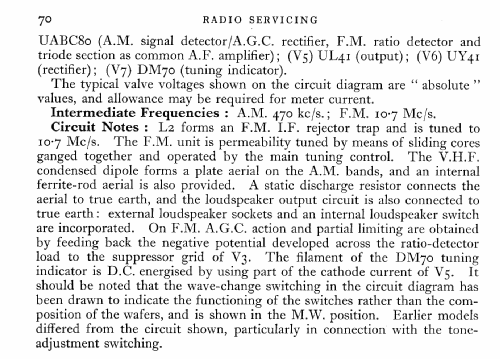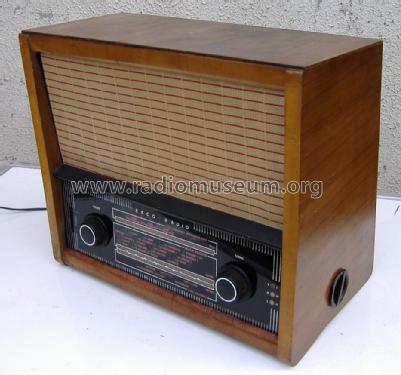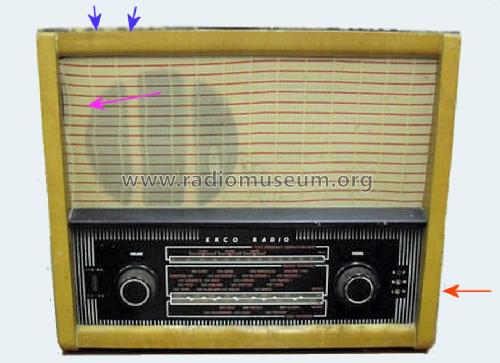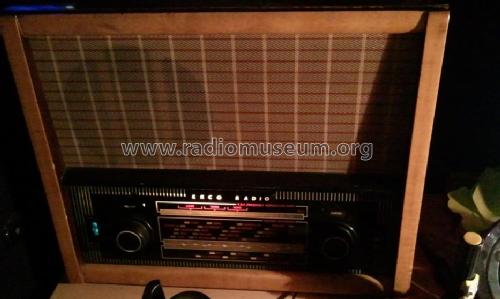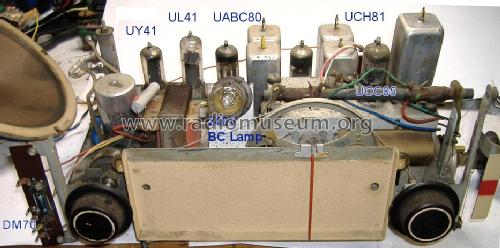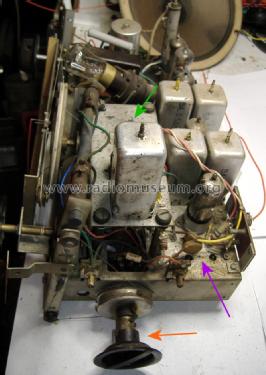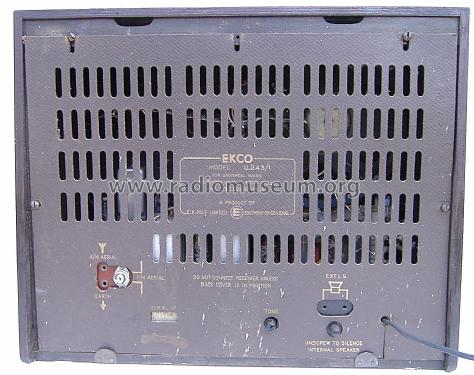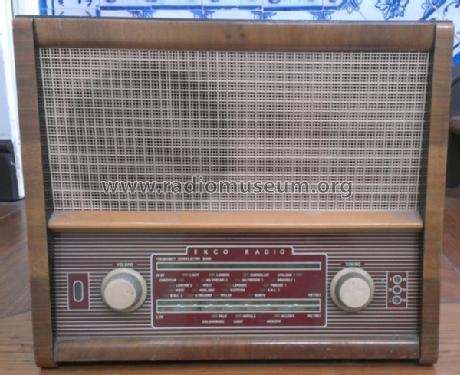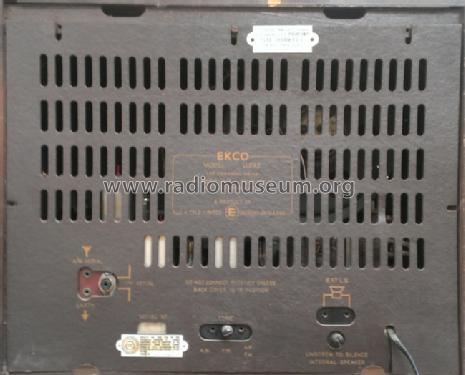- Land
- Grossbritannien (UK)
- Hersteller / Marke
- Ekco, E.K.Cole Ltd.; Southend-on-Sea
- Jahr
- 1955
- Kategorie
- Rundfunkempfänger (Radio - oder Tuner nach WW2)
- Radiomuseum.org ID
- 79364
Klicken Sie auf den Schaltplanausschnitt, um diesen kostenlos als Dokument anzufordern.
- Anzahl Röhren
- 7
- Hauptprinzip
- Superhet allgemein; ZF/IF 470/10700 kHz
- Anzahl Kreise
- 6 Kreis(e) AM 9 Kreis(e) FM
- Wellenbereiche
- Langwelle, Mittelwelle und UKW (FM).
- Betriebsart / Volt
- Allstromgerät / 200-250 Volt
- Lautsprecher
- Dynamischer LS, keine Erregerspule (permanentdynamisch) / Ø 8 inch = 20.3 cm
- Belastbarkeit / Leistung
- 2 W (Qualität unbekannt)
- Material
- Gerät mit Holzgehäuse
- von Radiomuseum.org
- Modell: U243 - Ekco, E.K.Cole Ltd.; Southend-
- Form
- Tischgerät-gross, - Querformat (breiter als hoch oder quadratisch).
- Abmessungen (BHT)
- 16.5 x 14 x 9 inch / 419 x 356 x 229 mm
- Bemerkung
- Released April 1955 price £19 16s 2d
Wavechange knob at side operates indicator on the Dial scale
Tone preset adjustment at the rear, like a TV preset control.
Screw knob at rear to turn off internal speaker (external speaker option even though a live chassis)
This UK model introduced the same year as the start of UK VHF-FM, which unlike 1949 Germany only duplicated MW-AM services.
VHF: 87 ... 100MHz
There are two cosmetic versions:
1) White plastic knobs, pale bar under speaker cloth/above dial glass, moulded white plastic mesh speaker grill.
2)Dark brown Bakelite knobs, black painted bar under speaker cloth/above dial glass, synthetic fabric speaker cloth with "gold" threads, woven vertical ribs and horizontal red thread details.
Examples of both these types have a rear mounted tone control not shown in the Trader Sheet, which appears to be a variable capacitor from grid to anode of the triode in UABC80.
Dial lamp is 15W "sewing machine" 230V-250V pygmy bulb, but with normal size BC base, not the smaller size now more common, but Feb 2012 still in local supermarket.
- Nettogewicht
- 7 kg / 15 lb 6.7 oz (15.419 lb)
- Originalpreis
- 20.00 GBP
- Datenherkunft
- Radio! Radio!
- Autor
- Modellseite von Konrad Birkner † 12.08.2014 angelegt. Siehe bei "Änderungsvorschlag" für weitere Mitarbeit.
- Weitere Modelle
-
Hier finden Sie 427 Modelle, davon 316 mit Bildern und 256 mit Schaltbildern.
Alle gelisteten Radios usw. von Ekco, E.K.Cole Ltd.; Southend-on-Sea
Sammlungen
Das Modell befindet sich in den Sammlungen folgender Mitglieder.
Forumsbeiträge zum Modell: Ekco, E.K.Cole Ltd.;: U243
Threads: 3 | Posts: 4
Because this is a "transformerless" AC/DC set using series heater chain and dial lamps are often not as long lived as tubes (valves), they chose a mains lamp rather than a low voltage part. Most Cookers and Fridges have low power screw in types, but the Ekco U243 uses a regular size BC (Bayonet cap) type common on normal room lamps in UK and Ireland.
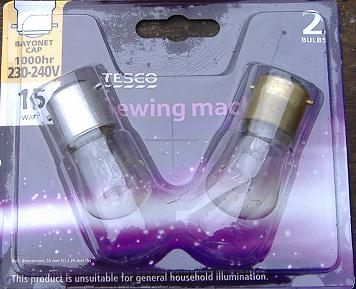
Amazingly the local supermarket sells them (February 2012) for sewing machines at the correct wattage of 15W.
Don't get the more common sewing machine lamp that is a smaller BC fitting (or the Screw type) by mistake:

They may vary in glass length and ftting length. There is some adjustment on the lamp bracket.
Michael Watterson, 15.Feb.12
The top was in very bad condition so it had to be stripped with "Nitromors". This removed the Ekco logo, so before re-spray with Acrylic lacquer the log was redrawn by hand with a metallic gold pen assisted by a stencil.

It's sharper in real life.
Before treating with Cupranol woodworm/timber preservative the interior was extensively scorched with a blow torch. Only a few flight holes bright, most were dark.
The bottom veneer was peeled completely and standing vertical. It was soaked overnight and then PVA glue. Parcel tape wraped around through back of case to hold it down on the curve till stuck.
A lot of the white paint had flaked from the dial glass. This was repaired with a Lidl "white pen" possibly intended for "freshening up" grout.
Acrylic varnish is likely more similar to the original than Polyurethane.
Michael Watterson, 15.Feb.12
The DM70 is quite a long life Magic Eye, but it is the opposite sense to the more common mains radio "magic eyes". It was developed for Battery sets, but due to the design, the bar is "full" for no signal (near zero AGC volts, most gain) and as the AGC voltage becomes more negative (to reduce gain as it's a stronger signal) the DM70 grows shorter. There are a few other mains Radio sets with DM70 by French and German makes too.
Michael Watterson, 08.Feb.12

